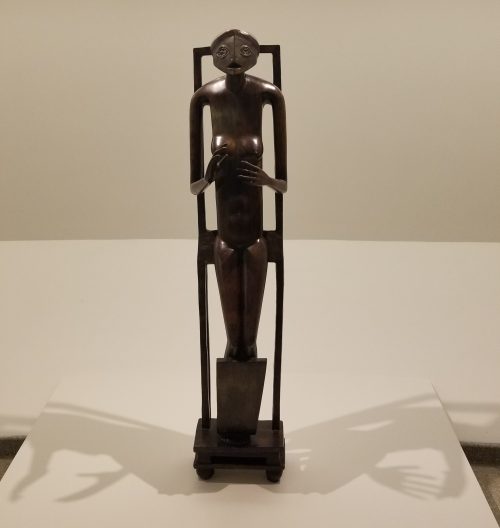
Tall Woman IV, 1960-61, Bronze; Monumental Head, 1960, Bronze; Walking Man I, 1960, Bronze.
Last month I visited the fantastic Giacometti exhibit currently on at the Guggenheim. I was exhausted, in a good way, after spending hours viewing his sculptures, sketches and paintings. I was fondly reminded of the exhibit when, this weekend, I started reading a collection of letters written by Simone de Beauvoir to her lover Nelson Algren. In a letter dated the 5th of November, 1947, she describes Giacometti’s messy studio and slovenly personal habits as well as his rejection of money and fame in favor of artistic integrity. I was so amused by her candid portrayal of his artistic process and his private life:
I don’t think I happened to speak about a very good friend of us who is a sculptor, though we see him often and he is maybe the only one we always see with pleasure. I tried to describe him partly in Le sang des autres. I admire him as an artist immensely. First because he does the best modern sculpture I know; then because he works with so much purity and patience and strength. He is called Giacometti, and will have a big exhibition of his works in New York next month. Twenty years ago he was very successful and made much money with a kind of surrealistic sculpture. Rich snobs payed expensive prices, as for a Picasso. But then he felt he was going nowhere, and wasting something of himself, and he turned his back on snobs; he began to work all alone, nearly not selling anything but just what was wanted to live. So he lives quite poorly; he is very dirty in his clothes. I must say he seems to like dirt: to have a bath is a problem for him.

Head of a Woman, 1926, Painted Plaster.
Yesterday I saw his house and it is dreadful. In a nice little forgotten garden, he has an atelier full of plaster where he works, and next door is a kind of hangar, big and cold, without furniture nor store, just walls and roof. There are holes in the roof so the rain falls on the floor, and there are lots of pots and pans to receive it, but there are holes in them too! He works 15 hours a day, chiefly at night, and when you see him he has always plaster on this clothes, his hands and his rich dirty hair; he works in cold with hands freezing, he does not care. He lives with a very young girl whom I admire much for accepting his life; she works as a secretary the whole day, and coming back just finds this hopeless room. She has no coat in winter and shoes with holes in them. She left her family and everything to come to Paris and live with him; she is very nice. He cares much for her but he is not of the sweet kind at all, and she has some hard moments to get through. What I like in Giacometti chiefly is how he could one day break into pieces all that he had done during two years: he just broke it and his friends thought it dreadful. He has his idea about sculpture, and for years he just tried and tried, like a maniac, not show anything, breaking and beginning again and again. And he could easily have got money and praises and a good name. He has very peculiar, interesting ideas about sculpture. Well, I think that now he really achieved something; I was deeply moved by what I saw yesterday.

Hands Holding the Void, 1934, Bronze.



I suspect this is the exhibition shown at Tate Modern last year. Quite spectacular! De Beauvoir’s letter captures Giacometti’s perfectionism so well. We’ve reaped the benefits but he must have been hell to live with.
LikeLike
I had read that there was an exhibit at the Tate. I suspect it had many of the same pieces. I have so many wonderful photos I took, only shared my favorites here. And, yes, he must have been so hard to live with!
LikeLiked by 1 person
I love reading this, and I imagine the exhibit was really interesting. How long is the exhibit running?
I’m also curious about the translator of that letter – is this A Transatlantic Love Affair? from The New Press?
LikeLiked by 1 person
Yes, that’s the edition I have. She wrote these in English herself which I had suspected as I was reading them. The editor’s note says that writing in English to Algren helped her written fluency. Very fascinating!
LikeLike
What a wonderful quote – thank you for sharing. I missed the show last year and I rather wish I’d seen it now. Yes – the artistic temperament – so often difficult for the women who live with them….. I wonder if a man would put up with the same treatment from a woman artist??
LikeLiked by 1 person
Great point. Artemesia’s husband walked out on her! I suspect many men would not put up with such treatment as Annette did!
LikeLiked by 1 person